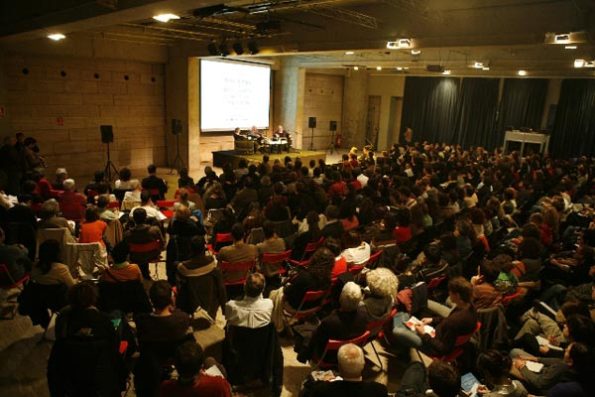Search
To search for an exact match, type the word or phrase you want in quotation marks.
A*DESK has been offering since 2002 contents about criticism and contemporary art. A*DESK has become consolidated thanks to all those who have believed in the project, all those who have followed us, debating, participating and collaborating. Many people have collaborated with A*DESK, and continue to do so. Their efforts, knowledge and belief in the project are what make it grow internationally. At A*DESK we have also generated work for over one hundred professionals in culture, from small collaborations with reviews and classes, to more prolonged and intense collaborations.
At A*DESK we believe in the need for free and universal access to culture and knowledge. We want to carry on being independent, remaining open to more ideas and opinions. If you believe in A*DESK, we need your backing to be able to continue. You can now participate in the project by supporting it. You can choose how much you want to contribute to the project.
You can decide how much you want to bring to the project.

An exhibition that looks at unhurried dialogues between film directors. An exhibition space, that wants to be the place, and the moment, to see an “other” kind of cinema. The quantifiable amplification of a proposal, and an idea, that has been presented previously. The CCCB continues to generate exhibitions that explore the limits of creative contexts, experimenting with formats while adhering to criteria defined by its own history and style of exhibiting.
“Totes les Cartes. Correspondències fílmiques” (All the letters. Filmic Correspondences), marks a step towards the consolidation of a cinematographic genre, that manifested itself for the first time in 2005 amongst Spanish film directors, the “filmed correspondence”. As ever, projects that arise from prior ideas presuppose an opportunity to innovate and test new formulas. The risky objective of the exhibition is to reunite six different collections of filmed-letters between filmmakers. It is an ambitious experiment that endeavours to take to an extreme the appropriation of an exhibition space by the language of film. A risk that is necessary in order to be able to explore the possibilities of this format of communication. It is the risk of the experiment.
The precedents of this peculiar form of establishing a relationship between creators, has its origins in the nineties, when the film makers Robert Kramer and Stephen Dowskin translated, for the first time, an epistolary relationship to the field of film. A few years later, the film director Naomi Kawase –who also participates in the exhibition- began an exchange of video-letters with the director Hirokazu Koreeda. Both experiences honed the fundamental traits of this experimental cinematographic format. A decade later, it is consolidated in Spain by way of the exchange of filmed missives between Víctor Erice and Abbas Kiarostami, as well as Isaki Lacuesta and Naomi Kawase, who are also present in the show.
In the short history of this format, the exhibition represents its coming out. In bringing together the letters exchanged between film makers from places as disparate as Mexico City, Gerona or Teheran, the show tries to define the new path that contemporary film has taken in going deeper into the use of writing as a tool with which to enrich its language. It is a tool for personal creation, where the projection of one upon the other opens new horizons. It is a profound experiment carried out over various years of postal exchange. The result is a reflection upon the relation that is established between different people who share certain affinities in their cinematographic creation. The objective is to show not just an isolated idea that has arisen between two directors, but a genre in itself, that has been adopted by both established and up-and-coming filmmakers from across the world.
Each creative couple has approached the project in a different way, but all show their acceptance of this new language, the format of the filmed correspondence has not altered nor been renewed. We simply see a selection, of participating film directors, that has expanded from two to twelve. It serves as a way of approaching more differences and juxtapositions of style within the same space. However at the same time, it makes more explicit the similarities and possible resonances within this group. By being able to compare a relationship between two creators with another, it is easier to understand the reach and possibilities offered by this way of conceiving the filmic gesture. This, apart from the importance of the works, forms the innovative feature of the show. However at the same time it is also the cause of its potential downfall. The infinite dimensions and nuances that this language discovers in the cinematographic field, can end up being eclipsed by the format taken by the exhibition.
From the beginning one can begin to intuit how different, compared with other exhibitions, the experience will be. Walls filled with explanatory text and not even a hint of an image. The pieces find themselves shut away, logically, within miniature screening rooms. Once all the information that extends along the walls of the passage has been assimilated, the moment arrives to submerge oneself in the darkness, to enter into two film directors’ vision of the world. The most shocking thing at this point, and obviously this varies depending on the spectator, is that we realise that the first projection – the first of six – lasts for one hour and 39 minutes. Sooner or later, it becomes evident that this pattern repeats for the length of the long and winding passage: where there is a text about the history of each relationship, a screen room, and a coffee machine, as a trusted ally against tiredness.
If we investigate a little, we realize that the route had already been adopted for the exhibition Erice-Kiarostami. Correspondències. The difference is that in Totes les Cartes, given the number of projected works and participants, the exhibition transforms into an epic documentary about the cinematographic fact. And the term “epic” is the best way to describe the show, with almost eight hours of projections distributed in six rooms. What it really forms is a challenge to exhibition conventions, given that the structure reminds us more of a film festival than of an exhibition, that adopts as its central theme and unique point of departure the filmed correspondence as the language of parlance.
It is true that it could become a very interesting experience. However the visitors have to invest a lot, paying attention to each projection in order to be able to capture all the intense relations that these images tell. Even so, a single visit is not enough to cope with this project, something that the CCCB had already envisioned. Ultimately in order to see the potential of this exhibition, what is needed above all, is the desire and the patience. As we said before, it is the risk of the experiment.

Verónica Escobar Monsalve is a restless soul, with a digital nature and an analogue heart. Her investigations centre on art and culture that mix the digital world with pre-digital thought. Art and culture that is capable of reflecting the complexity of today’s world. She believes in the vital importance of a critical spirit and how this can be applied to any facet in life, however difficult it may be.
"A desk is a dangerous place from which to watch the world" (John Le Carré)